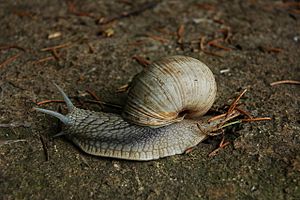Chedworth Nature Reserve facts for kids
Chedworth Nature Reserve is a special wildlife area in Gloucestershire. It's about 6 hectares big, which is like 15 football fields! This place is so important that it's officially called a 'Key Wildlife Site'.
The Gloucestershire Wildlife Trust owns and looks after this reserve. They bought it in 1969, not long after the Trust started in 1961. Nearby places like Chedworth Railway Tunnel and Chedworth Woods are also important wildlife spots. Some parts, like Chedworth Cutting Fault, are special for their geology, meaning they have interesting rocks and landforms.
Contents
Exploring Chedworth Nature Reserve
This amazing reserve is located right in the middle of the Cotswolds. You can find it between the villages of Chedworth and Withington. It sits on the south side of the River Coln Valley.
The reserve follows an old railway line that used to be part of the Midland & South Western Junction Railway. This railway opened in 1891 but closed down in 1961. So, the reserve is made up of the old track, railway cuttings (where the ground was cut away), and steep banks.
The reserve stretches for about 1800 yards through ancient woodland. This woodland, called Chedworth Woods, is one of the biggest ancient woodlands in the Cotswolds. The reserve is also right next to Chedworth Roman Villa, a cool place looked after by the National Trust.

The Tunnel and the Spring
At the south end, the reserve stops at the closed Chedworth Tunnel. This tunnel is a very important home for protected bats. They hibernate there in winter and roost at other times of the year. A special grille covers the entrance to keep them safe, while still letting them fly in and out.
At the north end, the reserve finishes at a lane called The White Way.
Close to the tunnel, there's a special tufa spring. This is where water full of lime comes out from underground. As the water flows over rocks and plants, it leaves behind limescale. This area is a great spot to find interesting liverworts and mosses.
There are also two embankment areas, which are raised banks of land. The southern one is near the tunnel. The northern one is drier and has special limestone grassland plants growing there.
Amazing Rocks and Fossils
When the railway was built, it cut through the ground. This exposed very old Cotswold limestone, about 180 million years old! Protecting these exposed rocks was a big reason why the Trust bought the site.
These Middle Jurassic oolitic limestones formed from layers of sediment in shallow, warm seas long, long ago. The patterns and fossils found in these rock layers are super important. They help scientists learn about what the environment was like and what creatures lived there millions of years ago.
The rock exposures in the reserve are mostly flat. However, you can see some faults, which are breaks in the rock layers. The cuttings in the reserve show a sequence from the Bajocian stage, which is a specific time period. These are considered some of the best and easiest to see in the country.
You might find fossils like bivalves (like clams), brachiopods (shellfish), and echinoids (like sea urchins) in the loose rock pieces. Remember, you can only collect fossils from the loose scree, not from the main rock walls.
Wildlife Wonderland
Chedworth Woods, where the reserve is located, is a semi-natural woodland. You'll find trees like pedunculate oak and ash here. There are also beech trees and conifers, plus hazel that has been coppiced (cut back to encourage new growth).
The reserve itself has ash, hazel, and dogwood plants. Beautiful flowers like primrose and greater butterfly-orchid have spread from the surrounding woodland. On the old railway trackbed, you can spot hairy violet, autumn gentian, blue fleabane, and large thyme (Thymus pulegioides).
Along the edges of the track, there are different shrubs, including the wayfaring tree. Woodland flowers like bluebell and ramsons grow well here. In the drier parts of the woodland, you might find wild strawberry.
The northern embankment is home to plants such as common milkwort, common centaury, and white clover.
Animals to Spot
Many different woodland birds have been seen here, including tawny owls, nuthatches, and wood warblers. The reserve is especially known for the woodcock.
Deer also use the site. You might see fallow deer, roe deer, and muntjac. Be careful, as adders (a type of snake) can be found here, and there are warning signs. If the weather is warm and humid, you might even spot the local Roman snail!
Dormice have also been recorded here. The hazel coppice provides a great home for them. These tiny creatures are a protected species.
In the more open, sunny areas, you can see beautiful butterflies. These include the speckled wood, comma, and silver-washed fritillary.
Keeping the Reserve Special
The main goal for conservation at Chedworth Nature Reserve is to make sure the amazing geological exposures (the exposed rock layers) are kept safe and clear for everyone to see and study.


